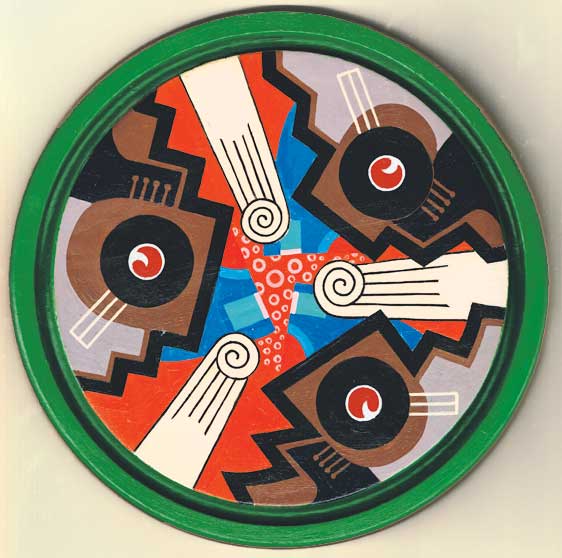I had the pleasure of having the generous assistance of Anita, a friend from choir, helping me do some artwork recording for a few hours on Monday. Anita creates multi-media artwork and has a website you can visit at http://www.anitadraper.org.uk.Anita’s fresh view, unencumbered by our family history, coupled with a bright enthusiasm, made the task fly by as we engaged with unwrapping the pieces one by one, scanning them front (high resolution), and back (low resolution), measuring them, recording relevant information in a spreadsheet, and naming files with accuracy to match.
We recorded 3 cutouts, and the 5 or so painted breadboards we still have in the collection. One surprise was a delightful piece which is only part-painted, but which I hadn’t seen before – it shows a group of abstract goats on a jagged mountain top. It was great having someone to share the work with – for the first time. I particularly enjoyed Anita’s alert and sensitive response to the pieces, and the numerous ideas she had about what we could do to show and promote the work. That was so refreshing!
The cut-outs and breadboards all date from a similar period in the 1990′s (I think – not many are dated). They exhibit strong, often abstract, designs, with bold intense colours and geometric shapes. Many of the cut-outs are illustrations of myths. Several of the breadboard pieces, like the tile designs, have interlocking layers of different forms, revealing a more formless background, as the space within opens up.
What do you see in the piece illustrated here? – I don’t know what the “meaning” is! Various forms suggest themselves – musical instruments, vinyl records, architectural features, eyes; earth, water and fire, food, cutlery, perhaps, or looking into an abyss, or up at a sky from an interior – all set inside a ring of bright emerald green. How intriguing! Dad never really spoke about them, so we don’t have many clues.
Given his range across painting and sculpture, its obvious when handling the piece, how attractive the idea of a circular painting embellishing the sculptural form of the breadboard would have been to him. He painted other objects – plates, tiles, a couple of furniture pieces, pebbles. There’s something rather ironic about the fact that Graham painted breadboards…when he had a lifelong difficulty with the idea of earning a crust in the usual way – money was not something he could relate to. But we survived, and in some ways, what a precious legacy, to have these pieces by his own hand to enjoy and share as time goes by. Nothing lasts, of course, but if we can become more alive and conscious through engaging with visual art, then our lives can be made richer, and our minds more subtle.


What a great morning I had helping Sophie. We unwrapped some work and were amazed at the quality of her father’s work. Both the breadboards and collages were such an interesting balance of colour and shape. The breadboards have a timeless quality about them. Each piece is charming by itself, but when grouped together as a set, they are even more impressive. I look forward very much to our next session.
And he was left-handed of course!
Another irony cannot go unmentioned – the structure of the paintings on the breadboard is very geometric, controlled and repetitive. But Dad never demonstrated these characteristics in his unorthodox method of slicing bread! To obtain a simple slice of bread, he held the loaf upside down in his right hand and proceeded to saw horizontally with his left hand, while turning the bread quickly with his right, with rather jagged and almost flamboyant arm movements. But it produced a good result nevertheless – method in his madness I guess